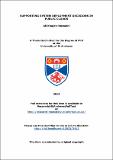Files in this item
Supporting system deployment decisions in public clouds
Item metadata
| dc.contributor.advisor | Sommerville, Ian | |
| dc.contributor.author | Khajeh-Hosseini, Ali | |
| dc.coverage.spatial | 181 | en_US |
| dc.date.accessioned | 2013-03-21T14:08:00Z | |
| dc.date.available | 2013-03-21T14:08:00Z | |
| dc.date.issued | 2013-06-26 | |
| dc.identifier | uk.bl.ethos.569022 | |
| dc.identifier.uri | https://hdl.handle.net/10023/3412 | |
| dc.description.abstract | Decisions to deploy IT systems on public Infrastructure-as-a-Service clouds can be complicated as evaluating the benefits, risks and costs of using such clouds is not straightforward. The aim of this project was to investigate the challenges that enterprises face when making system deployment decisions in public clouds, and to develop vendor-neutral tools to inform decision makers during this process. Three tools were developed to support decision makers: 1. Cloud Suitability Checklist: a simple list of questions to provide a rapid assessment of the suitability of public IaaS clouds for a specific IT system. 2. Benefits and Risks Assessment tool: a spreadsheet that includes the general benefits and risks of using public clouds; this provides a starting point for risk assessment and helps organisations start discussions about cloud adoption. 3. Elastic Cost Modelling: a tool that enables decision makers to model their system deployment options in public clouds and forecast their costs. These three tools collectively enable decision makers to investigate the benefits, risks and costs of using public clouds, and effectively support them in making system deployment decisions. Data was collected from five case studies and hundreds of users to evaluate the effectiveness of the tools. This data showed that the cost effectiveness of using public clouds is situation dependent rather than universally less expensive than traditional forms of IT provisioning. Running systems on the cloud using a traditional 'always on' approach can be less cost effective than on-premise servers, and the elastic nature of the cloud has to be considered if costs are to be reduced. Decision makers have to model the variations in resource usage and their systems' deployment options to obtain accurate cost estimates. Performing upfront cost modelling is beneficial as there can be significant cost differences between different cloud providers, and different deployment options within a single cloud. During such modelling exercises, the variations in a system's load (over time) must be taken into account to produce more accurate cost estimates, and the notion of elasticity patterns that is presented in this thesis provides one simple way to do this. | en_US |
| dc.language.iso | en | en_US |
| dc.publisher | University of St Andrews | |
| dc.subject | Cloud computing | en_US |
| dc.subject | Cloud adoption | en_US |
| dc.subject | System deployment | en_US |
| dc.subject | Elasticity | en_US |
| dc.subject | Cost modelling | en_US |
| dc.subject | Risk analysis | en_US |
| dc.subject.lcc | QA76.585K5 | |
| dc.subject.lcsh | Cloud computing | en_US |
| dc.subject.lcsh | Business enterprises--Computer networks--Management | en_US |
| dc.subject.lcsh | Cloud computing--Costs--Mathematical models | en_US |
| dc.subject.lcsh | Risk assessment | en_US |
| dc.title | Supporting system deployment decisions in public clouds | en_US |
| dc.type | Thesis | en_US |
| dc.type.qualificationlevel | Doctoral | en_US |
| dc.type.qualificationname | PhD Doctor of Philosophy | en_US |
| dc.publisher.institution | The University of St Andrews | en_US |
This item appears in the following Collection(s)
Items in the St Andrews Research Repository are protected by copyright, with all rights reserved, unless otherwise indicated.

